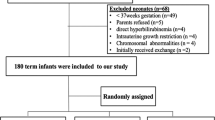Abstract
Objective
Jaundice is a common clinical problem in neonatal period which may result in brain damage even in healthy full term newborns, when it is severe. The aim of this study was to characterize the therapeutic effect of clofibrate in full term neonates who present with nonhemolytic jaundice.
Methods
A clinical controlled study was performed on 60 full term neonates who presented with non-hemolytic jaundice. 30 neonates were treated with a single oral dose of clofibrate (100 mg/Kg) plus phototherapy (case group), while 30 neonates received only phototherapy (control group). Both groups were compared in regard to post therapeutic mean total and indirect plasma bilirubin levels, admission duration and the rate of exchange transfusion.
Results
The reduction rate of total and indirect plasma bilirubin levels were significantly higher in the clofibrate-treated group as compared with the control group (P<0.05). The mean duration of admission was found to be reduced from 2.9 +/− 0.9 days in the control groupl to 2.2 +/− 0.6 days in clofibrate-treated group (P=0.002). The mean plasma total bilirubin level was lower in the clofibrate-treated group. No cases required phototherapy after 48 hour in clofibrate-treated group, while 9 neonates (30%) and 2 neonates (6.7%) required phototherapy after 72 hour and 96 hour respectively in the control group. There was no difference between both the groups for sex, the time of developing jaundice and the rate of exchange transfusion.
Conclusion
A single dose of clofibrate (100 mg/Kg) alongwith phototherapy is more effective than phototherapy alone in treating non-hemolytic hyperbilirubinemia in term healthy newborn infants.
Similar content being viewed by others
References
Fanaroff AV, Martin RJ. Neonatal-Perinatal Medicine, 8th ed. St. Louis, USA; Elsevier Mosby; Mosby St. Louis, 2006; 1419–1427.
William AH, Ballard RA, Gleason C. Avery’s Diseases of the newborn. 8th ed. 2005: 1226–1256.
Johnson LH, Brown AK, Bhutani VK. System-based approach to management of neonatal jaundice and prevention of kernicterous. J Pediatr 2002; 140: 386–397.
Dennery PA, Seidman D, Stevenson DK. Neonatal Hyperbilirubinemia. NEJM 2001; 344: 581–590.
Dennery PA. Pharmacological intervention for the treatment of neonatal jaundice. Semin Neonatal 2002; 7(2): 111–119.
Carmona MC, Vinaso MT. Activator of peroxisome proliferators-activated receptor-alpha induce the expression of the uncoupling protein-3 gene expression at birth. Diabetes 1999; 48(6): 1272–1222.
Bourget P, Broise I, Desmaris V, Gabilan C. Pharmacokinetics of clofibrate in jaundiced newborn infant at term. Arch Pediatr 1995; 2(8): 722–728.
Gordon B. Avery, Mary Ann Fletcher, Mhairi G. Mac Donald. Neonatology: pathophysiology and management of newborns, 5th ed. Lippincott Williams & Wilkins, 1999: 765–820.
Lindenbaum A, Hernandorena X, Vial M, Benattar C, Janaud JC, Dehan M et al. Clofibrate for the treatment of hyperbilirubinemia in neonates born at term: a double blind controlled study. Arch Fr Pediatr 1981; 38: 867–873.
Mohammad-Zadeh A, Farhat AS, Iran-pour R. Effect of clofibrate in jaundiced term newborns. Indian J Pediatr 2005; 72: 123–126.
Gabilan JC. Pharmacologic treatment of neonatal jaundice. A new approach. Arch Pediatr 1998; 5(11): 1274–1278.
Stem L, Khanna NN, Levy G, Yaffe SJ. Effect of phenobarbital on hyperbilirubinemia and glucuronide formation in new borns. Am J Dis Child 1998; 120: 26–31.
Hansen TW. Effect of phenobarbital in bilirubin metabolism rat brain. Biol Neonate 1998; 73: 106–111.
Wong RJ, Stevenson DK. Alternative metaloporphyrins for the treatment of neonatal jaundice. J Perinatol 2001; 21: 108–113.
Author information
Authors and Affiliations
Corresponding author
Rights and permissions
About this article
Cite this article
Eghbalian, F., Pourhossein, A. & Zandevakili, H. Effect of clofibrate in non-hemolytic indirect hyperbilirubinemia in full term neonates. Indian J Pediatr 74, 1003–1006 (2007). https://doi.org/10.1007/s12098-007-0184-x
Received:
Accepted:
Published:
Issue Date:
DOI: https://doi.org/10.1007/s12098-007-0184-x




